In this article, you can learn which are the Top 10 Strategy Board Games for Adults. I’ve included meatier games for semi-dedicated and dedicated competitive players. Only the best games are included – satisfaction is guaranteed!
Criteria for Top 10 Strategy Board Games for Adults in 2023
- Immersive. The game has to pull you in and hold you in its world for the whole time.
- Semi-time consuming (occasional get-togethers, 2 hours of playing time). No legacy/campaign games that take serious dedication to complete.
- Heavier board games with a lot of strategic options but not extremely heavy either (medium heavy). Something you can learn by playing it once and be fairly competent on the second run.
- Competitive – games where you can compete with each other for scores and other achievements.
- Good for 3-5 player groups, ideally 4 players (i.e. two couples)
Table of Contents
To quickly navigate through the article, click on a title below. There are also tags in the brackets, so you can quickly see what each game is about.
- & 12. Bonus entries
- Le Havre (port, resource management)
- Tzolk’in: The Mayan Calendar (worker placement, dynamic game board)
- Nemesis (horror, sci-fi, semi-cooperative)
- Orleans (medieval, bag-building)
- Clans of Caledonia (Scotland, farming, exporting)
- Concordia (Romans, Mediterranean, trading)
- Terraforming Mars (sci-fi, card-driven, engine-building)
- Great Western Trail (cowboys, path building, hand management)
- A Feast for Odin (Vikings, worker placement, polyomino puzzle)
- Scythe (diesel-punk mechs, resource management, engine-building)
There are affiliate links by the titles. I am affiliated with Amazon and will earn a commission if you buy something through my link.
12. Cribbage
Players: 1-4
Difficulty: Easy-Pro Modes
Cribbage is a time-honored card game that has been enjoyed for centuries. It is played with a standard deck of cards and involves players strategically forming card combinations, aiming to score points and ultimately reach the winning total of 121. With its unique scoring system, intricate gameplay, and the excitement of the “crib,” Cribbage continues to captivate players of all skill levels, making it a beloved and enduring classic in the world of card and computer games. You can also play Cribbage online
11. Backgammon
Players: 1-2
Difficulty: Easy
Backgammon is a classic board and computer game that blends strategy, luck, and skill. Played on a board with 24 points and 15 checkers per player, the objective is to move all your checkers around the board and bear them off before your opponent does. With dice rolls determining the moves and tactics like blocking and hitting opponent’s checkers, Backgammon offers a dynamic and thrilling gameplay experience for players of all levels. If you don’t have a backgammon board, you can play backgammon online.
10. Le Havre
Designer: Uwe Rosenberg
Year published: 2008
Players: 1-5, best with 2-4
Playing time: 30 minutes per player
Complexity: medium/heavy
Theme and Setting
In the busy French port of Le Havre, there’s no rest. Ships are being loaded with goods that local farms and industry provide, with construction and commerce flourishing as a result. These are rich times indeed and you’re one of the go-getters, trying to take benefit of the economy and get rich.
Overview of the Gameplay
Le Havre is an economical resource-management game. You try to establish a supply chain by collecting resources, converting them into more valuable resources, build buildings and ships.
The game starts out relatively simple. The port of Le Havre is pictured on the board, with different supplies of resources. Each turn, more and more resources will stack.
On your turn, you do one of two things:
- You take all the goods from one offer space.
- You move your worker to an empty building and use its ability.
While there are only a handful of buildings available at the start, some of them allow you to construct more and more specialized ones. Gathering resources, converting them into something more valuable (i.e. cows -> hides -> leather), and then selling them for maximum profit is the core of Le Havre.
Once the players start building, the game opens up. The buildings open up a web of interactions and possibilities and you’ll always be torn between doing something useful or just taking resources from the dock.
But if you don’t take them, someone else will, especially when it comes to food which is vital for feeding workers. The same goes for buildings – if it’s taken, you can’t use it. Other players can quickly ruin your ideas, so make sure you have plan B ready!
Not to mention, that you have to pay other players if you wish to use one of their buildings. That makes going for that lucrative must-have real-estate a race between players, as those buildings can bring in passive profit several rounds into the future. Later on, the game will introduce ships, which bring in regular food and allow you to ship off goods for money.
Orleans runs for a predetermined number of rounds and after that, the scores are summed up.
The artwork is very recognizable – you can’t miss Klemens Franz’s style. It works with economic board games perfectly – a bit cartoonish to lighten the mood, but easily readable.
There are a lot of components, especially resource tokens. They are cardboard and if you are not careful, you can spill them all over the place, creating a real mess. There are 125 different buildings, which makes the game different for every set-up.
Expansion
Le Havre: Le Grand Hameau (2010) introduces 30 new Special Buildings plus 3 cards with corrections to misprints from the base game. The deck is playable by itself (replacing the Special Building deck from the base game) or you can mix it with all the other Special Buildings.
The 2017 edition of Le Havre (the one you can buy now) already contains this expansion.
Main Features
- Simple at the beginning, but very complex towards the endgame.
- Meaningful, important decisions on every turn.
- Fun player interaction.
- A lot of resource tokens.
Who is Le Havre for?
If you like a deep, resource management strategy game, Le Havre is a good addition to your collection. It starts out slow, but soon your options will multiply and you’ll have free choice on how to maximize your profits. Just watch out for others around the table, as they are sure going to get in your way!
9. Tzolk’in: The Mayan Calendar
Designers: Simone Luciani, Daniele Tascini
Year published: 2012
Players: 2-4, best with 4
Playing time: 90 minutes
Complexity: medium/heavy
Theme and Setting
It’s not hard to guess where Tzolk’in is set: in the world of Mayans, the legendary Meso-American civilization. The theme and artwork are very Mayan-like, making it stand out from the rest of the board gaming world.
Overview of the Gameplay
Hand in hand with the Mayan theme goes the main attraction of the game: the moving cogs.
Tzolk’in is a worker placement game. You place and remove your workers from slots, carrying out actions that are on them. Taking resources, building buildings, and pleasing the gods, all convert to victory points. That’s where the cogs come in. They provide a moving platform, changing the action slots your workers are on with every turn.
On your turn, you have two actions available. You either place any number of workers on the cogs (possibly paying corn to feed them) or you remove them, carrying out actions that they are currently on.
That makes Tzolk’in a very strategic game. You must plan several rounds ahead, placing workers and then removing them when they’re exactly in the slot you need. There’s very little luck involved and player interaction is limited to competing for slots, so it’s all about planning your path to victory. There are multiple paths available.
It’s also this deterministic nature of the game, that is its biggest shortcoming. It doesn’t have a lot of exciting moments, but if you’re a true strategist, you will be in heaven, without any random factors to destroy your schemes.
Expansions/Editions
One expansion exists, Tribes & Prophecies. It adds 13 tribes with special abilities, making the game more diverse. The lack of exciting moments is partly fixed by the 13 prophecies (events, that the players must prepare for). Moreover, components for the fifth player are included. Overall, a very good complement to the base game.
Main Features
- Original theme.
- Innovative moving board.
- Low luck factor with many paths to victory.
- Little player interaction.
Who is it for?
Tzolk’in: The Mayan Calendar is an excellent strategy game hidden beneath The Mayan theme and the moving cogs. There is very little luck involved, meaning this is a game for players that like to analyze and plan several rounds ahead.
8. Nemesis
Designer: Adam Kwapiński
Year published: 2018
Players: 1-5, best with 4-5
Playing time: 90-180 minutes
Complexity: medium
Theme and Setting
I was in my teens when I first watched Alien, a 1979 classic horror movie, directed by Ridley Scott. I was petrified and extremely intoxicated by it at the same time.
Nemesis gives you the opportunity to re-live the movie as a board game. OK, it may not have the official license, but that’s pretty much the only detail that is missing. This is Alien as a board game.
Overview of the Gameplay
Nemesis is a semi-cooperative dice-rolling exploration game. The basics are pretty simple – each turn you get to do two actions (this time dictated by the cards you hold in your hand). After players, it’s the game’s turn.
Every player controls a different character (Soldier, Mechanic, Scout, etc.), each with different abilities, equipment, and deck. You find yourself on a spaceship, but unsurprisingly, you are not alone. Your task is to complete one of the two random objectives and make it back to earth safely.
But sitting put won’t win. You have to explore the ship and find rooms that allow you to complete certain tasks (like sending a signal to Earth from the comm room or doing research in the lab) and bring you closer to your objectives.
But your movement will produce noise, which will inevitably draw out Intruders (the aliens), which will make your day go from bad to worse. You can fight them, but honestly, your best bet is to try to escape.
Here comes the twist which elevates the game to a whole new level. Remember – it’s semi-cooperative. Each player also has a personal objective, which allows him alone to win the game. Sometimes you may prefer to leave your fellow players to the mercy of Intruders and casually embark on an escape pod.
It’s moments like this, the tense horror atmosphere, and the pristine sci-fi theme, which make Nemesis a memorable experience. You don’t play this game for strategy (although there’s quite some of it in there) and game mechanics – you want to feel the coldness of space as you open the hatch and squeeze the alien outside.
A big contributing factor is the presentation. The components and art are excellent, but the miniatures take the crown. Especially the Intruders. They are not exactly like H.R. Giger’s, but they are very detailed and have their own horrifying charm.
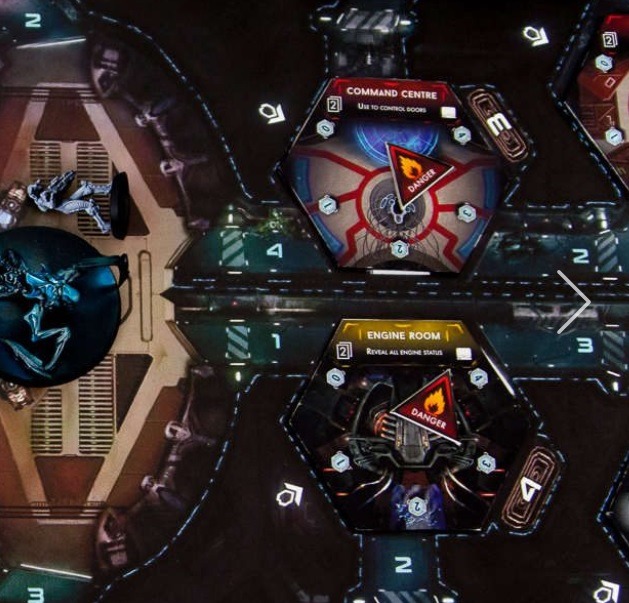
Expansions/Editions
Some of the notable expansions and Kickstarter stretch goals:
- Nemesis: Untold Stories #1 and #2 (2019) provide several additional co-op game scenarios for Nemesis. They are presented in a graphic novel/comic-book style
- Nemesis: Aftermath is the epilogue mode, that you can play after the game. New characters enter the ship and try to understand what happened on the Nemesis.
- Nemesis: Void Seeders. The crew of Nemesis must face Void Seeders, a new type of enemy who tries to spread insanity on the board.
- Nemesis: Medic introduces a new playable character.
As mentioned, Nemesis was launched through a Kickstarter campaign, which means it’s pretty hard (expensive) to get, especially if you want all the expansions.
Main Features
- Beautiful, detailed miniatures.
- Game mechanics convey the atmosphere of a sci-fi horror adventure.
- Elements of cooperation, bluff, and backstabbing.
- Expensive.
Who is it for?
Although Nemesis offers plenty of depth and strategy, it’s not all about that. It’s about being in a sci-fi horror movie. You dabble the corridors in fear, knowing that one wrong step can mean a difference between winning and dying. Other players seemingly help you, but you can’t trust anyone.
It’s that experience that will keep you coming back for more and not the sense of winning and losing. It may be expensive, but if a few of you chip in, it’s well worth it.
7. Orleans
Designer: Reiner Stockhausen
Year published: 2014
Players: 2-4, best with 4
Playing time: 90 minutes
Complexity: medium
Theme and Setting
Set in the medieval era around Orleans and the Loire area, the theme is not the most exciting part of Orleans. Although the artwork is done by Klemens Franz, the cover is not going to turn heads. But don’t go away just yet.
You play as a merchant, taking trips to other cities and trading posts to acquire goods. But you will need help in the form of farmers, merchants, boatmen, craftsmen, knights, scholars, and monks.
Overview of the Gameplay
What drives the action in Orleans is a bag of the aforementioned citizens. Each turn of the 18, you will draw a certain number of tokens from your bag and strategically place them on your board, performing actions (like acquiring more tokens, moving the merchant figure on the map, adding a new action tile, etc.).
Moving the merchant allows you to pick up goods on the map and build trading posts, which are both very positive for your end score. Another way to score points is to place your tokens on the Beneficial Deeds board, where you can help build public works like canals.
The final (and the most important) way to earn points are the Development tracks. These track your progress in various areas, and provide in-game bonuses, special abilities, and multipliers for other scoring options. In the end, the tracks themselves are scored. You should definitely not neglect Development tracks in Orleans.
Orleans comes with streamlined gameplay, but it gives players a lot of freedom in their moves. There are always multiple ways of using your tokens. You can even save them up for the next round or just partially fill out the action slots.
Getting proper tokens in your bag (building your bag) is also a big deal. True, there is an element of luck when drawing from your bag, but it’s the kind of luck you make yourself. You’ve got to plan ahead – for example, don’t put scholar tokens in it just to fill the bag if you don’t plan to use them.
The amount of tokens in the game is finite, so there’s a soft cap on how far players can go on some of the tracks. Watch other players and alter your strategy if necessary. Maybe you can earn more points with the trader if there are no monks available?
Check out Quacks of Quedlinburg for a lighter bag-building game or Altiplano, Orleans’ unofficial sequel.
Expansions/Editions
- Orléans: Invasion (2015) adds six event-driven scenarios (cooperative and competitive) and new action tiles.
- Orléans: Trade & Intrigue (2016) introduces new action tiles and four modules: Orders, new Events, new Beneficial Deeds and Intrigue, a replacement Beneficial board.
Both expansions are excellent additions that really prolong the lifespan of Orleans by adding a lot more gameplay variety and replay value.
Main Features
- Bag-building at its finest.
- A lot of meaningful options during the game.
- Smooth gameplay.
Who is it for?
They say that you shouldn’t judge the book by its cover and Orleans is a true testimonial to that saying. Below the theme lies an excellent bag-building game with a lot of choices and strategies behind it.
I’d recommend this to anyone willing to give it a chance.
6. Clans of Caledonia
Designer: Juma Al-JouJou
Year published: 2017
Players: 1-4, best with 4
Playing time: 30 minutes per player
Complexity: medium
Theme and Setting
The 19th-century industrial revolution was a time of great change. Scotland was in transition from an agricultural land of the old ways to an industrialized country, focused on trade and export. But the bulk of people still lived off the land.
You play as one of the historic clans, trying to benefit from the newly created situation. Produce, trade, and export agricultural goods and profit from selling your whiskey worldwide.
Overview of the Gameplay
The game starts by drawing a clan for each player. Clans come with different abilities, some being better in certain areas. This creates asymmetrical gameplay and implementing your clan’s advantages in disadvantages into your strategy is very important.
This diversity also ensures a lot of replay value. Every clan plays differently and there are other game-to-game factors that change (like port tiles, scoring criteria, and contracts that your clans seek to fulfill). All 8 clans are well-balanced, but some are more beginner-friendly than others.
The game is played over five rounds, with each of the rounds consisting of several phases, with the main one being the action phase. Players can perform any number of actions, limited only by the resources they obtain:
- Place units on the map: animals that produce wool or milk, fields that produce grain, workers that increase coin production, or buildings that can convert basic resources into more valuable goods (whiskey, cheese or bread).
- Trade goods on the market. Prices go up or down according to your actions.
- Acquire a contract
- Fulfill a contract, exporting your goods in return for victory points and other rewards.
- Upgrade technology, increase your trading capacity and building ability, and grant other bonuses.
Players perform actions one by one until everyone passes. It’s a very elegant soft cap, that doesn’t tie you to any worker slots, dice, or cards, but lets you develop your strategy freely.
Rounds end with production and scoring phases, with an additional final scoring at the end of the game.
Read the full Review of Clans of Caledonia
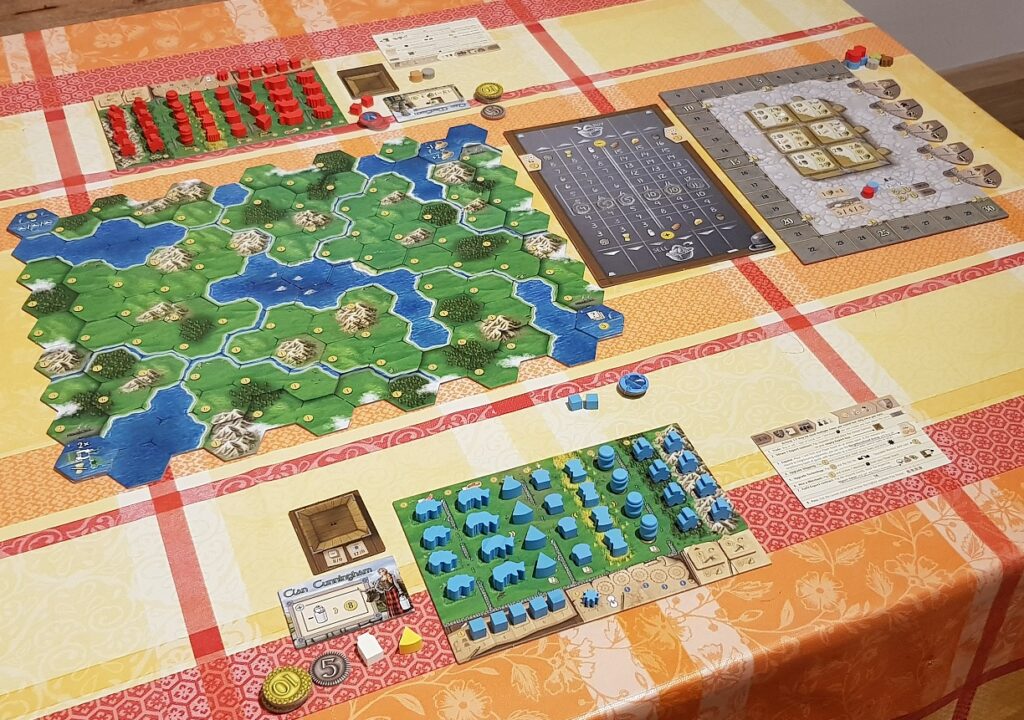
Main Features
- Easy to get into, but still very deep with a lot of complex decisions.
- A lot of replay value.
- Wooden components look and feel great
Who is it for?
There are a lot of things to consider in Clans of Caledonia. Money comes hard and you have to spend every pound wisely. Your decisions are important and have far-reaching consequences. This is a dream for hardcore players that like to optimize things.
On the other hand, Clans of Caledonia is very friendly to beginners. You only do one thing in a turn, and with the help of a reference chart, this makes it very easy to understand how the game works.
Clans of Caledonia is almost like a hidden gem. Not many people are talking about it, but those who have tried it will recognize it as one of the best eurogames ever. Yes, it is that good.
5. Concordia
Designer: Mac Gerdts
Year published: 2013
Players: 2-5, best with 4
Playing time: 100 minutes
Complexity: medium
Theme and Setting
The Mediterranean at the height of the Roman Empire was a very prosperous place. With peace, uniform law, and a common currency, trade flourished. As goods from all sides of the sea changed hands, a lot of people profited.
In Concordia (Roman for “harmony”) you play as a leader of one of the Roman trading dynasties. Your goal is to develop your trade network, send colonists, appease gods, and above all else, get rich.
Overview of the Gameplay
Concordia is a peaceful hand and resource management game. In front of you is the map of the Mediterranean with provinces and cities. The city tiles are shuffled, so they produce different goods every game.
Each player starts with a colonist in Rome, starting resources, and a deck of cards. It’s this deck that is the driving force behind the gameplay. Each turn you will play one card from your hand. The basic cards are:
- Prefect: You choose a province that will produce (giving out goods to everyone there, but you get extra resources) or you decide to take the money accumulated on bonus tokens
- Architect allows you to move colonists on the map and have the ability to build trade outposts (if you have the resources).
- Mercator: Buy or sell goods for money.
- Senator: Buy more action cards (more specialized) from the card market.
- Diplomat: Copy the last card any other player has played.
- Tribune card allows you to take cards back from the discard.
Some actions require a cost in resources to be paid. For example, with the architect, you can build as many trading posts as you can afford (or none).
Timing your cards right is crucial and allows for powerful chain abilities (gather resources, move around and build, acquire more cards), especially if you keep an eye on other players and use the Diplomat at the right time.
The Tribune is another important card. Although you must sacrifice an entire turn, it’s the only way to get discarded cards back into your hand. Moreover, the more cards in the discard, the more money you get by doing so.
OK, so I’ll just use all my cards and then play the Tribune to get them back, you say. A sound tactic, but there are some cards that you will want to use more often. You want that Diplomat in your hand at all times, should an opponent play something you would benefit from. This means timing the Tribune is not that straightforward and it comes with carefully weighing the pros and cons.
This all leads us to acquiring new action cards and scoring. Every card has a God flavor (Mars, Minerva, Saturn, Jupiter, etc.) and each God prefers you to do something else. Every Saturn card will give you one point for every trading post, Mars gives points for colonists, and so on. The more cards and favorable actions of a certain god you have, the more points will that net you.
The scoring is not immediately obvious and it could take new players a game or two to get a hold on. But the general strategy revolves around expanding on the map, trying to use other players’ productions as much as possible, acquiring new cards, and aligning your strategy with the Gods you have.
But don’t think you can do the same thing every game. Things will be very different each game – the setup changes meaning players will never expand into the same provinces. That means that you have to re-invent your strategy every game.
Expansions/Editions
There are several map packs available that allow more strategic challenges. They contain two maps per pack:
- Concordia: Britannia / Germania (2014)
- Concordia: Gallia / Corsica (2016)
- Concordia: Aegyptus / Creta (2017)
- Concordia: Balearica / Cyprus (2019)
Concordia: Salsa (2015) is an expansion containing two maps (Byzantium and Hispania), a sixth commodity (salt -“salsa”), and new Forum card mechanics.
Concordia: Venus (2018) is a standalone edition of Concordia with some added features: team play, goddess Venus cards, and 4 maps (Imperium/Cyprus, Hellas/Ionium).
Owners of the original can buy the Venus expansion which includes everything needed to bring the base game up to the Venus edition.
I’d suggest you try to acquire the Venus edition of the game and add the Salsa expansion. You can acquire the maps later if you so wish. If the Venus edition is unavailable, the base game will more than suffice.
Main Features
- Excellent eurogame with a lot of replay value.
- Simple gameplay (one card per turn), but offers immense strategic depth.
- Close to no luck involved – predominantly skill-based game.
- Multiple paths to victory.
5 Reasons Why You Should Play Concordia
Who is it for?
Concordia is an example of a well-made eurogame. Simple rules (only four pages, the rest is clearly explained on the action cards) with deep gameplay that awards skillful play, a lot of important decisions to be made, meaningful player interaction, and a lot of replay value.
Don’t be fooled by the unappealing box (the in-game art and components are excellent by the way) – Concordia is rightfully among the all-time greats.
4. Terraforming Mars
Designer: Jacob Fryxelius
Year published: 2016
Players: 1-5, best with 3-4
Playing time: 120 minutes
Complexity: medium
Theme and Setting
It’s the 25th century and the colonization of Mars is in full swing. But the planet is still far from habitable. Oxygen levels and temperature are far below desirable levels. The surface must be filled with oceans, forests, and cities.
Only large multinational corporations are able to take on a project of this scale. You play as one, competing with others for victory points, rewarded for your contribution to terraforming and other infrastructural and scientific advancements.
The theme is one of the strongest points of Terraforming Mars. The main contributor to the atmosphere is unique project cards, which are based on futuristic events. To add to the immersion, cards are equipped with relevant imagery, although a bit inconsistent.
Read the full review of Terraforming Mars
Overview of the Gameplay
After choosing your corporation, you are put in front of a hexagonal Mars board. You are free to do as you please: place oceans, forests, and cities as standard projects. Crash an asteroid to increase the temperature of the planet. Or do it gradually and build a power plant instead.
But building just standard projects would get boring pretty soon. Each round you will have a chance to reserve project cards. Reserving them costs money, so choose carefully. These special projects can make or break you. They are expensive to build but offer substantial rewards.
Project cards are an outstanding feature in Terraforming Mars. There are 208 in the base game and even after several games, you will encounter new ones. They can alter your resource income, add special actions (like placing oceans cheaper, paying to increase your TR, adding resources on themselves for extra VP), place special tiles (mines, factories, nuclear zones …), harm your opponents, and so on.
These project cards keep the game fresh and diverse even after dozens of plays.
You have to manage your money carefully as there is never enough to build everything you want. Other resources are heat, energy, and greenery. You can increase production values on them, which gives the game an engine-building component.
The game ends when the surface is sufficiently terraformed. The points are then summed up.
Expansions/Editions
After you familiarize yourself with the base game, five expansions are available:
- Hellas & Elysium introduces a new double-sided playing board with two new maps.
- Venus Next adds an extra playing board on the side, the Venus.
- Prelude‘s main feature is 35 prelude cards which offer initial boosts to your corporation or terraforming process.
- Colonies expand your reach in the outer solar system.
- Turmoil is the latest and largest expansion. It brings the focus back to Mars, introducing Global Events and the Terraforming Committee, adding a political layer.
Underwater cities is a similar card-driven sci-fi game, but it’s set underwater.
Main Features
- Immersive project cards.
- Very good solo mode.
- Components are only average.
Who is it for?
Terraforming Mars is rightfully regarded as one of the best board games. It comes with an immersive sci-fi theme and good engine-building mechanics. I haven’t mentioned the exceptionally single-player mode, which is a great added bonus.
Although the out-of-the-box components are not very good, there are third-party solutions available for you enthusiasts. You will also benefit from excellent expansions that dose in extra stuff at a nice pace.
3. Great Western Trail
Designer: Alexander Pfister
Year published: 2016
Players: 2-4, best with 3-4
Playing time: 75-150 minutes
Complexity: medium/heavy
Theme and Setting
Do you know where the word cowboy comes from? That’s right cow-boy is a guy taking care of cattle, herding it, and selling it for profit. Gunslinging is just for self-defense.
In Great Western Trail you play as such a rancher. Your pastures have been plentiful and you’ve got some extra cows that you’re willing to sell. The only problem – you’re in Texas and the cows have to get to Kansas City. On your horses, cowboys and let’s go!
Overview of the Gameplay
While the theme in Great Western Trail is quite strong, it’s not its strongest point by far. The crown goes to game mechanics or a mesh of different game mechanics that work together as a whole, creating (on the surface) a simple game, but deep down there are a lot of intricacies and co-dependencies.
So, you start in Texas with a hand of cows (cards). During the game, you will make several trips to Kansas City and along the way, you will have a chance to improve your hand (element of deck-building) by visiting certain locations, hiring cowboys (you can’t take care of all those cows alone), workers, and engineers.
You can run into floods, rockfalls, drought, and Indians – which can help you or not. All this is for the simple goal of herding your cattle to its destination and making money.
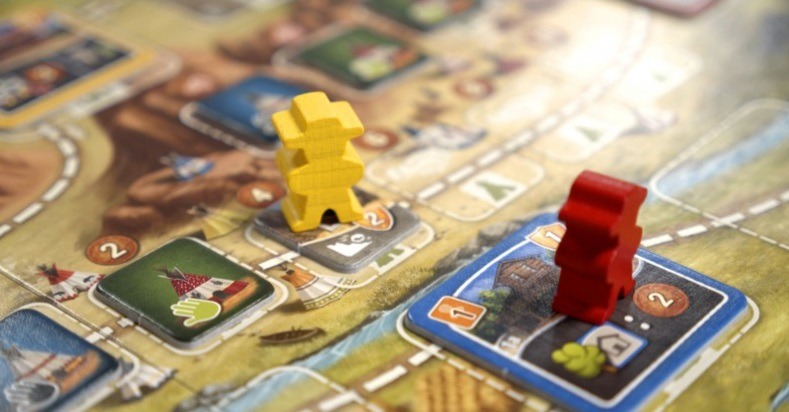
But the core gameplay is simple: you move your meeple along the path (which also forks out, meaning there’s not only one way to go) and what you can do is dictated by the building you land on. These involve manipulating cattle cards in hand, moving the train, hiring employees, or purchasing cattle.
You can move several spaces (3-4 at the beginning and up to 7) and it’s your choice how far and fast you want to go. You can also construct your own buildings along the way and create your own specialized path (an engine). There’s some iconography to be learned, but the symbols are generally clear and intuitive.
This relative simplicity makes the game run smoothly and there is little analysis paralysis because the game consists of a lot of small (yet important) decisions.
Your abilities, multipliers, and stats are tracked on your personal board, which looks intimidating at first but provides all the important bits of information with ease.
Another important mechanic is the train, which works on how much profit you make with a sale. You want your breeding value (cow cards) to be in harmony with the train’s destination. Otherwise, you have to pay for the difference, which eats your profits.
Great Western Trail is like a giant puzzle. As you travel, you improve your hand (adding more valuable cattle), improve the path for future deliveries and move the train on its track. Will you move faster and make more deliveries or take it slowly, make the best of your trip, improve the path more, and make your future trips more profitable?
It’s an exercise in optimization. But even though there are so many different factors, it never gets overwhelming or confusing. It may take you a game to familiarize yourself with all the symbols, but the red thread is always obvious – you’re moving your cattle to sell it.
The buildings on the path ensure that the game is vastly different every time. Even one building set-up differently will require you to alter your strategy. There are more than enough available and you can randomize neutral buildings as you please.
The game also works well with all player counts, but it comes alive with a full 4 players. Even though such a game can last for close to 3 hours, it never outstays its welcome.
Expansion
Great Western Trail: Rails to the North (2018) further expands the train mechanics, making it a lot more important and meatier than the base game. Although the expansion is excellent, I’d only recommend it to seasoned players.
2021 saw the release of the Second Edition, which features an updated appearance and a few minor gameplay tweaks, but it’s essentially the same game.
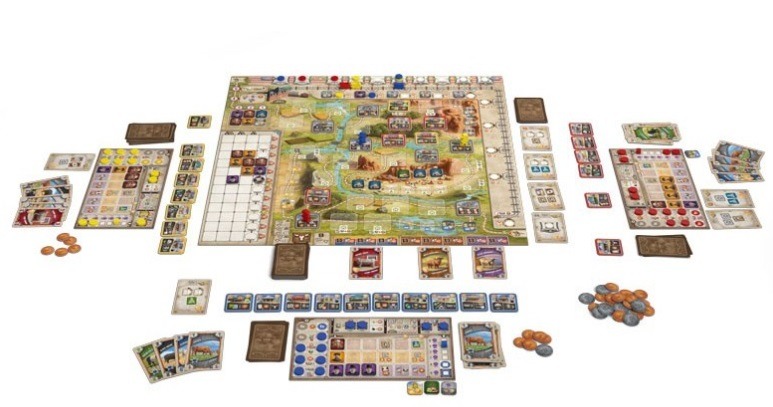
Main Features
- Several game mechanics work together as a masterpiece of game-making.
- A lot of meaningful player decisions.
- Incredible replay value.
Who is it for?
Great Western Trail is a masterwork of a board game. There’s a lot going on and it may take you a while to grasp. But it won’t let you go after that: the trips To Kansas City have never been so eventful and full of decisions.
2. A Feast for Odin
Designer: Uwe Rosenberg
Year published: 2016
Players: 1-4, best with 1-4
Playing time: 30 minutes per player
Complexity: medium/heavy
Theme and Setting
You control a Viking tribe that farms, hunts, explores, and raids. Your goal is to salvage as much loot and cover your home board with it, earning victory points.
Overview of the Gameplay
The game has a lot of options and interconnected moving parts. To help players comprehend everything, the game is divided into 6 or 7 rounds (short or long game) and each round is further divided into phases.
Phases include:
- taking a new Viking worker from the banquet table,
- harvest food,
- explore other boards (Shetlands, Faroes, Iceland, Greenland),
- draw weapon cards you need for hunting or pillaging,
- place workers and carry out actions,
- determine a new starting player
- calculate income,
- breed animals,
- feast (placing food on the banquet table and earning victory points),
- claim bonuses (if you have any on your home board),
- add new mountain strips for basic resources and
- remove Vikings and prepare for the next round.
You can place loot items on your home board at any time. The same goes for playing special action cards, buying ships, and equipping them for whaling or pillaging.
You can place workers into 61 different slots, but they are sensibly categorized:
- building houses and ships,
- hunting,
- managing livestock,
- producing resources,
- sailing, occupying new lands.
Many of them do similar things, only at different costs or efficiencies. That means there is always something to do and you will have a lot of options on your turn. More advanced actions require certain prerequisites. For example, you’ve got to have a ship ready and equipped if you want to go pillaging, whaling, or trading.
Performing actions will lead to you getting loot. These are simply different shaped tiles, that you have to place on your home board and cover the negative points on it. It’s a little puzzle game on its own (similar to Patchwork) and a very smooth game mechanic that is seamlessly implemented.
If your board is not big enough for all your goods – that’s where additional boards (Shetlands, Faroes, Iceland, and Greenland) come into play. You can colonize them as well.
At the end of the last round, points are added together and the winner is declared.
Read my full A Feast for Odin Review
Expansion
A Feast for Odin: The Norwegians (2018) includes four new islands (Isle of Man, Isle of Skye, Islay, Outer Hebrides) and Irish coastal settlements. It polishes and tweaks several game mechanics and is a very welcomed addition. Once you tried it, you won’t ever play A Feast for Odin without it!
Main Features
- A large number of mechanics, concepts, and details blended into a masterpiece strategy game.
- Relatively easy to get into and understand.
- Offers a lot of options and different paths.
Who is it for?
A Feast for Odin is one of the best worker-placement board games available and is definitely the most complex Viking board game available. It’s also (arguably) Uwe Rosenberg’s greatest game and a must-have for a board gamer, that enjoys deep, thinking games.
1. Scythe
Designer: Jamey Stegmaier
Year published: 2016
Players: 1-5, best with 1-5
Playing time: 90-115 minutes
Complexity: medium
Theme and Setting
Eastern Europe, just after The Great War. People are trying to rebuild, but peace is not yet destined to happen. Cold war looms over the region as factions fight over land and resources with war leftovers – giant diesel-punk mechs.
Scythe is set in a world, created by artist Jakub Rozalski. The theme is a strong trump of Scythe and it shows itself through the mech miniatures and especially through encounter cards, which are a work of art themselves.
Overview of the Gameplay
Each player receives a randomly selected faction mat which starts in a predefined location on the game board. Faction mats determine the faction’s special abilities, starting power, and starting combat cards.
Read the full review of Scythe
There are 5 factions in the base game, each of them with a uniquely designed main character, workers, and mechs: Rusviet Union, Crimean Khanate, Nordic Kingdom, Polania Republic, and Saxony Empire. Every faction has a special ability (or two) which makes them all unique to play.
On your turn, you choose one of four action sections on your player mat. This will be your action for the turn. Each action has two rows: top and bottom, with the top one being performed first.
Top actions are cheap and basic (like moving and producing resources), but bottom actions are more advanced (deploying mechs, building structures, upgrading your player mat, enlisting soldiers) and require more resources to perform. You can perform both rows (if you can afford it), just one or neither.
While the game focuses on the economical side – you gather resources, to expand and increase the effectiveness of your engine, sooner or later, your units will meet the enemy on the map. Combat uses a very clever system of secretly assessing power, that completely eliminates the element of luck. It still is a very costly affair and best avoided.
During the game, you will complete special achievements (i.e. upgrade your mat 6 times, deploy all 4 mechs, have 8 workers on the map, win a combat encounter, have 18 popularity, have 16 power, etc.), which will grant you a star.
When any of the players reaches 6 stars, the game ends, and the end-game scoring starts. Stars, coins, territories, and resources controlled, along with other bonuses are considered. Popularity plays an important role as it acts as a multiplier. Winning the hearts of the people is important in Scythe!
Expansions/Editions
- Invaders from Afar (2016) is the first expansion for Scythe. It adds two new factions, both very specialized and challenging to play. You can read my review of Invaders from Afar here.
- The Wind Gambit (2017) adds Airships and Resolutions. An airship is a new type of unit that flies above the map. Resolutions alter end-game conditions.
- The Rise of Fenris introduces a story-driven eight-episode campaign. It’s especially recommendable if you plan to play Scythe solo.
- Encounters is a pack of 32 fan-designed new encounter cards.
Main Features
- Brilliant art and components.
- Many paths to victory.
- Asymmetric factions.
Who is it for?
Scythe is a board game with excellent presentation. We already mentioned the art, but the components are of equally high quality.
The game mechanics are a masterpiece as well. There are a lot of things to look after: the map, your personal board, resources, and other players. But the gameplay remains smooth, thanks to easy-to-read components. The variables and the very-asymmetric factions guarantee high replay value.
The expansions only complement and complete this and make Scythe one of the best board games of all time and a must-have for a strategy-loving board-gamer.
Further reading:
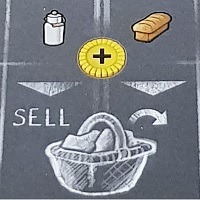















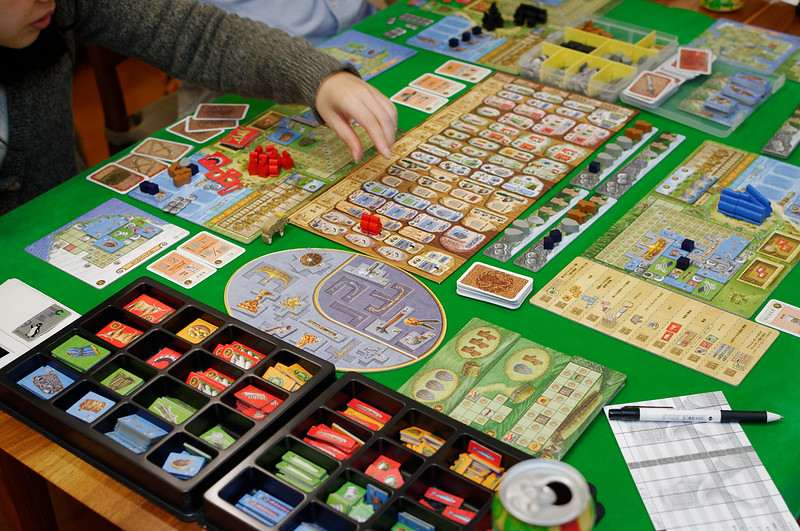



If you love myths and legends, this game is for you! Lagim is a one-of-a-kind card game of strategy and chance. Check “LAGIM” Facebook page and website for more info.
Looks interesting. We’d be happy to review a press copy, just email us. 🙂